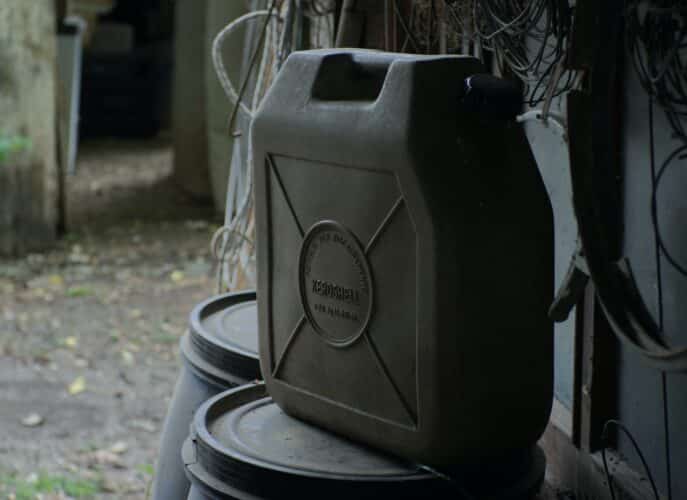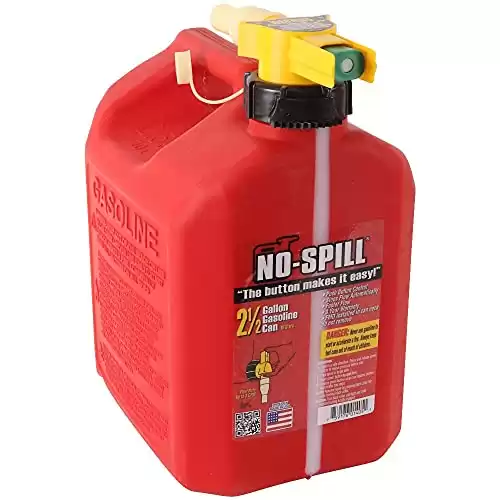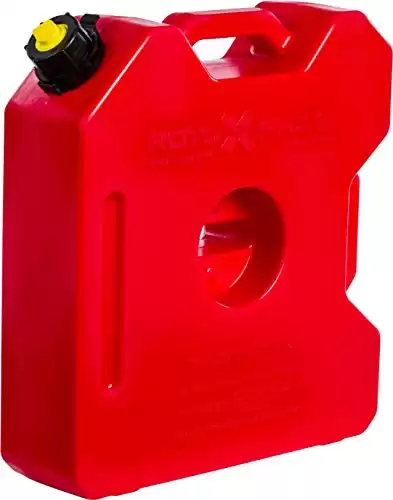Hey there, motorbike fanatics! Ever thought about your trusty gas can as much as your beloved ride? Let’s dive into the exciting world of fuel storage – yep, it’s more fun than you’d think!
First things first, we’re gonna talk about how to pick a gas can that won’t let you down. Just like a perfect ride, the right can should be top quality, sturdy, and reliable. After all, we don’t want any fuel parties that we didn’t plan, right?
Next up, we’ll inspect our gas cans. A quick look-over can save a lot of hassle later – think of it like a quick check-up for your can. Remember, no one likes surprises when they’re dealing with flammable liquids!
Speaking of cleanliness, let’s scrub those cans clean! Trust me, it’s worth the elbow grease. A sparkly can is a happy can, and we want those gas cans grinning from handle to spout.
Ever thought about storing fuel in your gas can? We’ve got you covered there too. I’ll share some handy tricks for filling, storing, and moving your can around. But don’t worry – there’s no heavy lifting involved.
Keeping your gas can in top shape is key. We’ll go through the steps of checking for damages, replacing any broken parts, and giving your gas can a proper home. After all, your gas can deserves a little love too.
And finally, we’ve got some golden rules for safe gas can storage. Because the last thing we want is to turn your garage into a fireworks display. So sit tight, fellow bikers, and let’s get our gas cans ready for the long haul!
Plastic Jerry Cans are the typical plastic jugs that you can find in most garages, usually storing enough gas to keep the lawnmower running. These are not the best choice for carrying extra fuel on your motorcycle. Generally, the shape of the can and the lack of tie-down handles makes it difficult to secure the can to a motorcycle.
But because everyone has one around, they are listed here as an option.
- Super Cheap
- Convenient, You Might Have One
- Difficult To Mount To Bike
- Not Made For Motorcycle Transport
Preparing Your Gas Can
To prepare your gas can for motorcycle fuel storage, you need to choose and inspect the right gas can. This can be done by observing certain factors and conditions. Once you have the right can, you need to inspect it for damages and clean it thoroughly. In this section, we will discuss these important tasks and guide you through the process of preparing your gas can for long-term storage.
Choosing the Right Gas Can
For a safe and problem-free fuel experience, picking the correct gas can is key. Consider the size of the can, depending on your use. Ensure it’s made of high-quality material that won’t corrode or react with chemicals. Also, the lid and spout should be secure for spill-free transportation. Labels with UN ratings and flammability risks are essential too.
Plastic or metal? Understand the role of gas can material in motorcycle fuel storage and make an informed decision based on your specific requirements.
Using a low-grade gas can may lead to disastrous consequences like spills, fires or explosions. So, make sure the container meets your specific needs. As a pro tip, use separate containers for different types of fuels and label them properly. Don’t forget to inspect the can, unless you want a major explosion!
Curious about the best way to Carry Extra Gas on Your Motorcycle? Check out these 5 clever and safe ways to carry extra fuel on your motorcycle!
Inspecting Your Gas Can
Inspect Fuel Container
Before refueling, inspect your fuel container. Keep you and the environment safe. Follow these 4 steps:
- Check for leaks and damage on the outside.
- Make sure seals and caps are in place.
- Check spout for debris before use.
- Verify the container has a label of its contents.
Do this inspection properly. Also, store fuel containers away from sun and heat.
Fuel Container Facts
A 2019 Global Market Insights study said that, by 2025, the jerry cans market size will exceed $877 million. Clean your gas can with dish soap. Like a spa treatment, but with soap instead of cucumber water.
Cleaning Your Gas Can
Maintaining your fuel canister is essential. Cleaning it prevents contamination and lowers the risk of fire hazards. Follow these three steps for a spotless canister:
- Empty the fuel in a safe way.
- Mix hot water and soap. Scrub the inside with a brush or sponge.
- Rinse and let air dry upside down.
Before use, check the container for cracks or damage. If any issues arise, fix or replace it.
For safety, store your gas can in a cool, dry place, away from sunlight and out of reach of kids. With these simple steps, your canister will be ready when needed.
Ensure a secure storage process by following these safety tips for storing motorcycle fuel in gas cans—protect yourself, your bike, and the environment.
Stay safe and keep your gas can clean! And remember to always keep your enemies close, you never know when you’ll need to burn some bridges.
Plastic Jerry Cans are the typical plastic jugs that you can find in most garages, usually storing enough gas to keep the lawnmower running. These are not the best choice for carrying extra fuel on your motorcycle. Generally, the shape of the can and the lack of tie-down handles makes it difficult to secure the can to a motorcycle.
But because everyone has one around, they are listed here as an option.
- Super Cheap
- Convenient, You Might Have One
- Difficult To Mount To Bike
- Not Made For Motorcycle Transport
Storing Fuel in Your Gas Can
To ensure that your motorcycle has an adequate supply of fuel, storing gasoline in a gas can is a great solution. To make the most out of this solution with the sub-sections on filling, storing, and transporting your gas can properly, you must exercise care and attention to detail.
Filling Your Gas Can
Gas Can Fuel Storage – A Professional Guide!
For safe, efficient storage of fuel, you need to know how to fill a gas can properly. Follow these 3 steps for effective filling:
- Place the can on a flat surface – away from flammable materials.
- Remove the nozzle cap and insert it firmly in the fill neck of the can.
- Fill it slowly – stopping when it is about 95% full, to avoid spills.
Only approved containers are designed for fuel storage. Make sure you have good ventilation during gasoline transfer, to prevent dangerous fumes.
Surprise tip – never store a gas can in your car’s trunk or interior. In Florida, a man had an explosion in his car due to heat generated by the sun. The gasoline-filled canister ignited – causing significant damage to the vehicle and putting his life at risk.
Store your gas can safely, and use common sense. Follow these tips to prevent disaster!
Storing Your Gas Can
Gas Can Storage: How to Store Fuel Properly.
Avoid wasting fuel and causing hazardous incidents. Proper storage is key. Here’s what you need to know:
- Select the Right Container – one made for storing gasoline.
- Check the Label – make sure it says ‘suitable for gasoline’ or ‘UN/DOT.’
- Keep it Clean – before filling, make sure it’s dry both inside and out.
- Fill it Up Properly – only fill up to 95% to allow room for expansion when gasoline heats up.
- Choose a Safe Location – store away from direct sunlight and heat sources.
- Seal the Cap Tight – so dirt and debris can’t enter.
Check local laws for storage regulations and if you’re allowed to store fuel at home. Follow safety protocol when transporting containers and ensure proper ventilation. Even empty gas cans can be dangerous if mishandled or not stored properly. Someone I once met used an old metal paint canister as a gas container. This caused an explosion during transport, with severe injuries and property damage. Invest in proper equipment!
Transporting fuel is risky, but thankfully my gas can doubles as a flotation device if needed.
Transporting Your Gas Can
Stackable fuel storage containers are made of very heavy-duty and durable, thick plastic. They are rectangular in shape and have a cut-out in the centre to accommodate a mounting bracket.
They come in a variety of capacities ranging from 1 gallon to 4.5 gallons.
The beauty of these fuel containers is that they stack neatly together and are secured with a mounting bracket. The enables you to carry even more fuel as needed along with other fluids, like drinking water.
- Durable, Crack & Leak Resistant
- Carry Multiple On One Mount
- Perfect For Adventure Bikes
- Very Efficient Use Of Space
- Stack Neatly Together
- Includes Fill Spout
- Crush Resistant
- Expensive
When transporting a fuel-filled gas can, keep these steps in mind:
- Ensure it’s tightly sealed.
- Put it upright in the trunk or truck bed.
- Secure with straps or bungee cords.
- Avoid placing near flames or heat.
- Keep windows rolled down for ventilation.
- Wear gloves and protective gear when handling the container.
- Don’t overfill and only use gas approved by authorities.
Pro Tip: Keep a fire extinguisher nearby in case of emergencies! Lastly, keep the can clean – messier than gasoline is a messy garage!
Maintaining Your Gas Can
To maintain your gas can for motorcycle fuel storage with ease, check out the sub-sections ahead. Checking for damages, replacing damaged parts, and storing your gas can properly are the key solutions that this section offers. Follow these guidelines to prolong the life of your gas can and ensure that your motorcycle fuel remains clean.
Checking for Damages
Inspecting for potential damages and flaws in a fuel can is essential for operational safety. Unacceptable uncertainties when it comes to flammable liquids! Here are some points to keep in mind:
- Look for any dents or scratches on the gas can, especially near the nozzle area. These deformities could lead to leaking vapors.
- Check the cap’s integrity. A loose seal can let dirt and moisture in, causing corrosion or rusting.
- See if the spout valve works properly. Blockages or stiffness can make it hard to pour fuel accurately.
Neglecting these small elements can cause major problems. So, it’s best to inspect after every use. Keeping up with maintenance is better than dealing with unwanted outcomes. And, replacing a damaged part is better than learning the hard way that duct tape isn’t always the solution.
Replacing Damaged Parts
When your gas can has broken pieces, take action fast! Here is how to make sure you replace it the right way.
- First, figure out which parts are damaged. It could be the spout, cap, or vent. Make a list so you can buy the exact replacements.
- Get the replacements from a trustworthy website or shop and make sure they fit with your gas can model.
- Carefully replace the old pieces with the new ones, no gasoline spills!
Also, check for any other potential damage before use. After you switch everything, check again to make sure it’s secure before handling or storing it.
Pro Tip: Get extra replacement parts in case you have future problems with your gas can.
Proper gas can storage: no backyard explosions!
Storing Your Gas Can Properly
Store your gas can with proper care! Keep it in a cool, dry place away from heat and flames. Make sure the cap is tightly sealed. Upright position – no stacking or piling. Check for cracks, leaks and rust. Replace any damaged parts.
Gasoline fumes are harmful and flammable – be careful! Don’t forget to store outdoors only when needed – deterioration might occur. TÜV SÜD America suggests following strict regulations of materials, labeling and performance standards.
Be wise – store your gas can safely or you’ll be in hot water like that mixtape you made in high school.
Tips for Safe Gas Can Storage
To ensure that you store your gas cans safely, this section provides some valuable tips for safe gas can storage with three sub-sections as a solution. These sub-sections will enlighten you on the importance of keeping gas cans away from children, storing gas cans away from heat sources, and always labeling your gas cans.
Keep Gas Cans Away from Children
Protect children by storing gas cans safely. Keep them away from kids and store in a secure place. Label containers correctly so people can recognize them quickly. Store at room temperature and avoid direct sunlight or heat sources – they can deform the containers and cause leaks.
Do regular checks for dents, cracks or rust. A family once lost their home due to a fire from an unlabeled gas can left outside. Take necessary precautions to ensure safety. Labeling and storing gas cans is more than complying with regulations; it’s for your family’s safety. If you want a fireball, store gas cans near heat sources!
Store Gas Cans Away from Heat Sources
Gas cans should be tucked away from sources of heat. Heaters, stoves, and direct sunlight are all off-limits. To keep your gas cans safe, put them in a cool, dry area. Also, don’t expose them to flames. They’re highly flammable and can ignite quickly.
When storing, make sure the cans are upright and tightly sealed. Do not store them near electrical appliances or any equipment that may spark. Plus, never keep them inside the house. Use approved storage containers for gasoline. These containers are designed to prevent ignition and explosions. They also have features such as pressure relief valves.
It is essential to practice proper gas storage. A serious mishap can occur if storage isn’t done correctly. So, label your gas cans. Don’t risk mistaking them for your morning coffee!
Always Label Your Gas Cans
When it comes to safe gas can storage, labelling is key. Without the right labels, there’s a risk of wrong identification or mix-ups with other chemicals – potentially leading to a hazardous outcome. Here are four tips for labelling your gas cans correctly:
- Use waterproof and durable stickers or labels.
- Include purchase date, type of fuel and use.
- Don’t remove or deface original manufacturer’s label.
- Use unique labels for each gasoline source.
Labelling should also include safety precautions! When refilling the container with gasoline, make sure the nozzle doesn’t touch it. This helps reduce static electricity build-up.
Several accidents have occurred due to improper labelling. In 2005, a jetski propellant drum was mixed with diesel fuel at a marina, resulting in explosion and damage to nearby property.
Proper labelling of gas cans is vitally important. It not only saves lives, but also prevents backyard explosions that ruin barbecues.
Conclusion and Final Thoughts.
To have a long-lasting gas can, clean and maintain it properly! Regular cleaning will prevent build-up and rust. And, store it in the right conditions. Being an essential tool for motorcyclists, take pride in managing it well.
It’s also important to buy quality gasoline – it’s a must for your motorcycle engine and gas can. Pay attention to the cleanliness and quality of the gas for a top-notch riding experience.
Quality should be your top priority when selecting a motorcycle fuel storage can; discover the importance of investing in a reliable option to ensure a safe and efficient experience.
Once you’re done, store the gas can carefully. Don’t put it on surfaces that could get wet or be affected by temperature changes.
In conclusion, having a well-maintained gas can is key for successful rides. Don’t let it ruin your future experiences!
When it comes to storing motorcycle fuel, it’s essential to choose the best gas can that meets your needs—check out our comprehensive guide to find the perfect solution for you.









